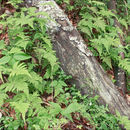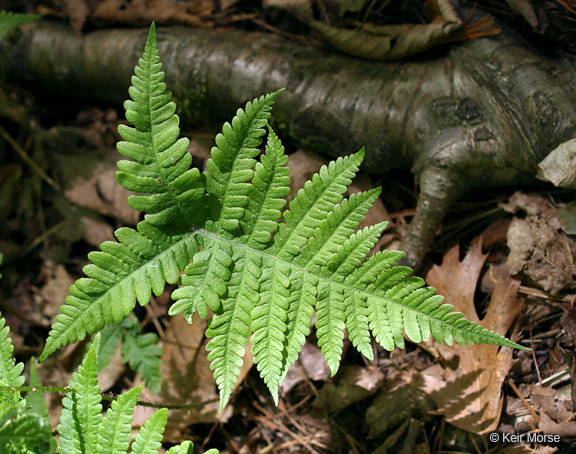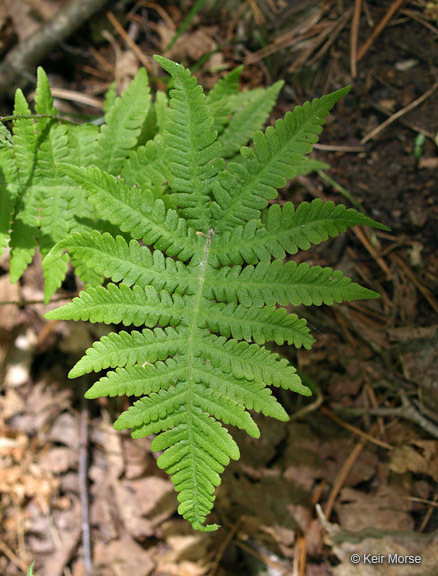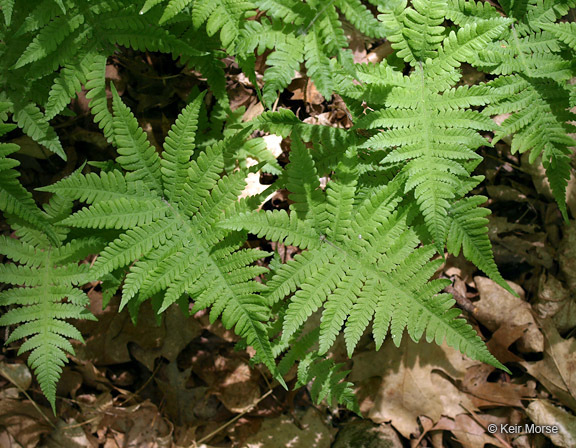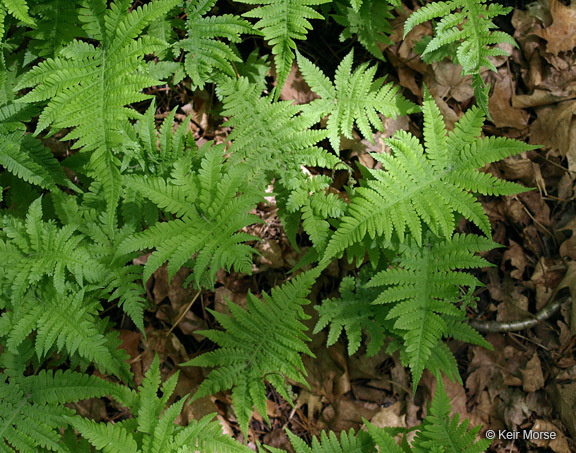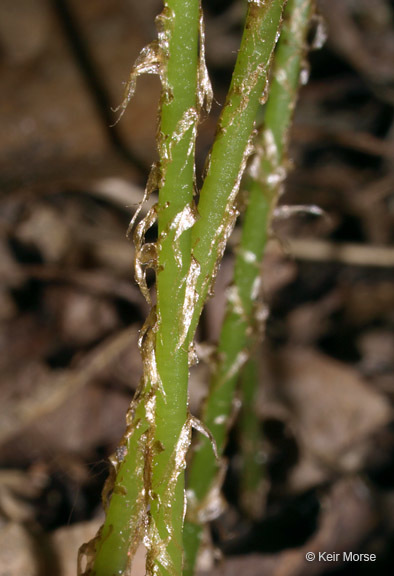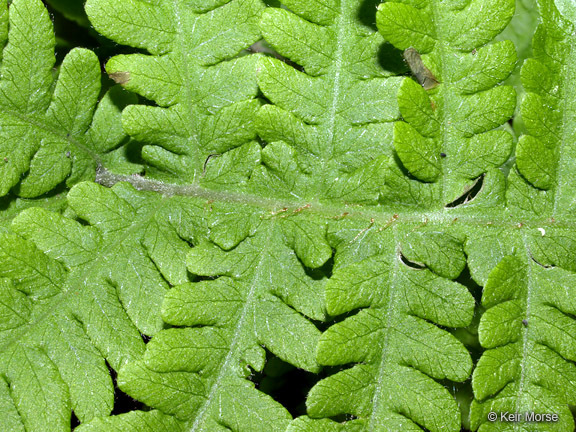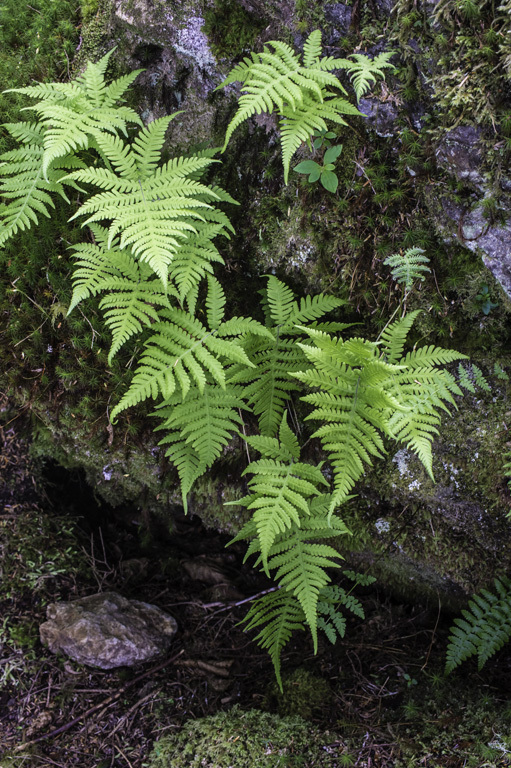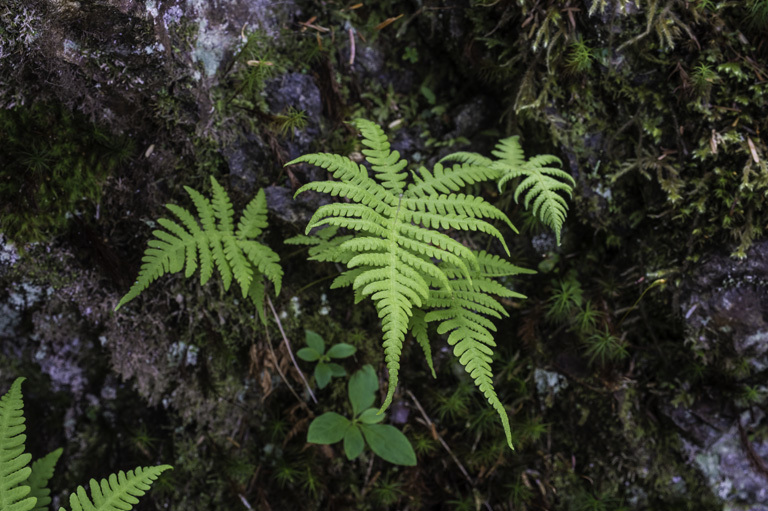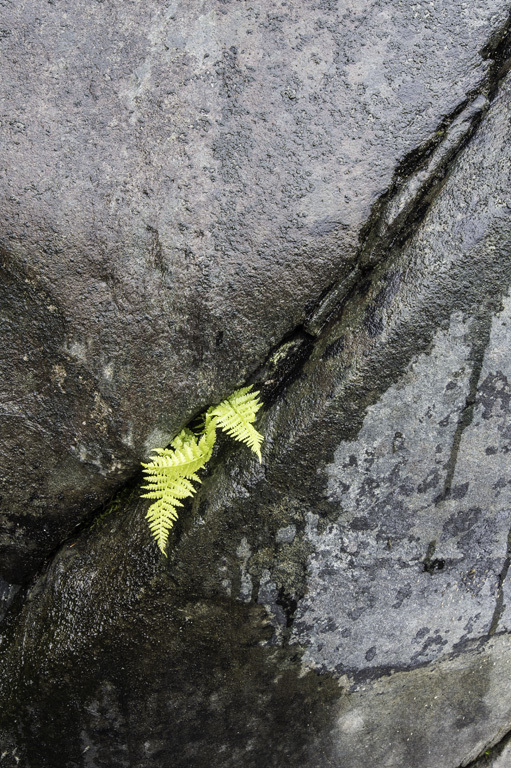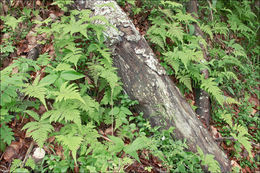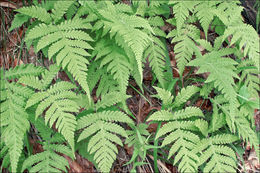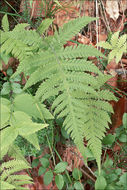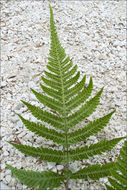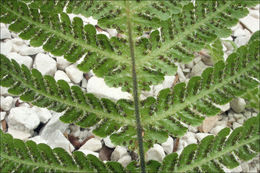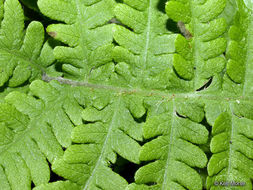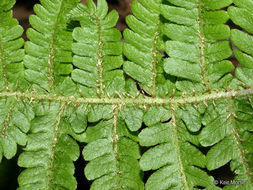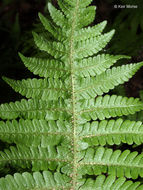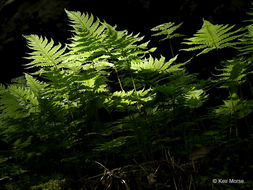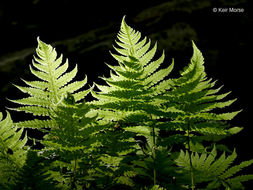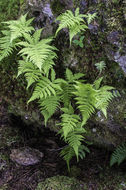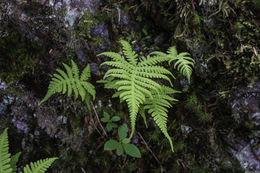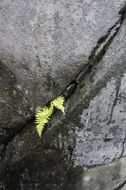-

Slo.: navadna bukovica - syn.: Dryopteris phegopteris (L.) Christ.,Thelypteris phegopteris (L.) Sloss., Lastrea phegopteris (L.) Bory. - Habitat: overgrown old river deposits, edge of Fagus sylvatica forest, calcareous ground, locally acid ground (Vaccinium myrtillus dominant in ground vegetation), locally almost flat terrain, half shade, partly protected from direct rain by tree canopies, average precipitations ~ 3.000 mm/year, average temperature 4-5 deg C, elevation 995 m (3.300 feet), alpine phytogeographical region. - Substratum: soil. - Comment: Ferns are often neglected plants even by nature lovers. Allegedly they look 'all the same'. Truly they are not colorful and have no conspicuous sexual organs and in Europe some kind of green is almost all what they can display in terms of color. However, in a sense of graphical impact they can be strikingly beautiful. The richness of delicately shaped leaves is surprising. Species differ in habitus and morphological details, which are sometimes inconspicuous to such an extent, that proper determination of species is quite a demanding task and a trained eye is highly welcome. - Phegopteris connectilis is relatively easy to determine. It is a common, widespread, Euro-Siberian, North American fern, growing in all parts of the Alps, but in spite of this, it is seldom recognized by its name. Rather small but graceful plant can be recognized by its compound triangular or arrowhead-shaped leaves - fronds, which are pinnately divided. Their leaflets are further pinnately cleft almost to the midrib and, what is particularly characteristic for this species, broadly attached to the central axis of the leaf (see Fig.6.). Another easy to recognized trait is orientation of both largest leaflets at the bottom of the leaf. Both point backwards while all other leaflets point either forward or stand perpendicular to the central leaf axis (see Fig.2.). Spore producing organs in sori - black 'dots' on usually underside of fertile fronds - are positioned near the edge of the leaflets and have no umbrella-like protection cover called indusium like many other ferns. - Ref.: (1) M.A. Fischer, W. Adler, K. Oswald, Exkursionsflora sterreich Liechtenstein, Sdtirol, LO Landesmuseen, Linz, Austria (2005), p 237. (2) K. Lauber and G. Wagner, Flora Helvetica, 5. Auflage, Haupt (2012), p 60. (3) A. Martini et all., Mala Flora Slovenije, Tehnina Zaloba Slovenije (2007) (in Slovene), p 94. (4) D. Aeschimann, K. Lauber, D.M. Moser, J.P. Theurillat, Flora Alpina, Vol. 1., Haupt (2004), p 70.
-
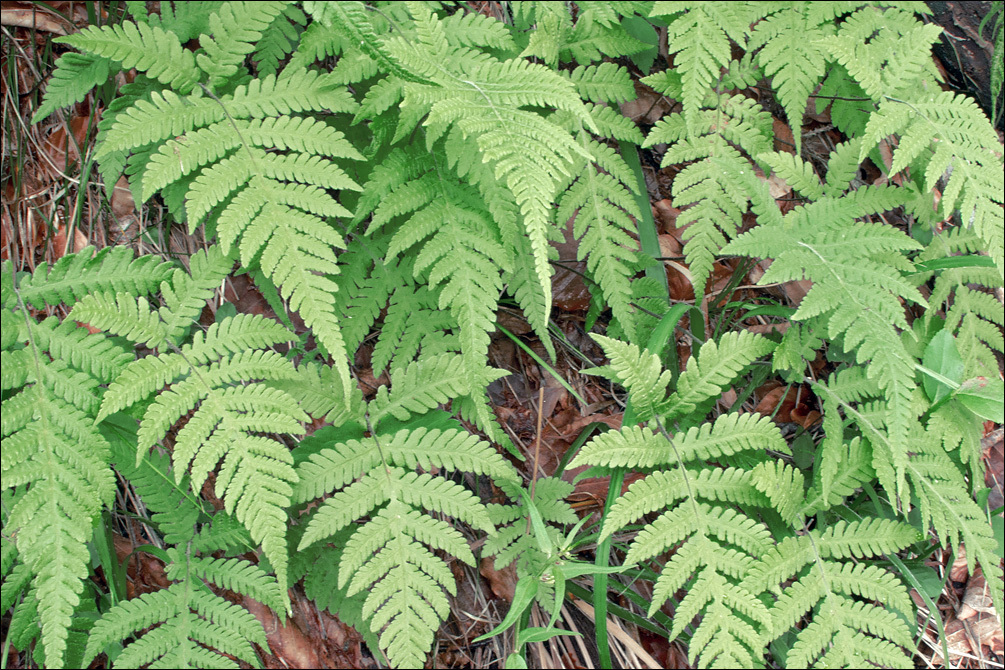
Slo.: navadna bukovica - syn.: Dryopteris phegopteris (L.) Christ.,Thelypteris phegopteris (L.) Sloss., Lastrea phegopteris (L.) Bory. - Habitat: overgrown old river deposits, edge of Fagus sylvatica forest, calcareous ground, locally acid ground (Vaccinium myrtillus dominant in ground vegetation), locally almost flat terrain, half shade, partly protected from direct rain by tree canopies, average precipitations ~ 3.000 mm/year, average temperature 4-5 deg C, elevation 995 m (3.300 feet), alpine phytogeographical region. - Substratum: soil. - Comment: Ferns are often neglected plants even by nature lovers. Allegedly they look 'all the same'. Truly they are not colorful and have no conspicuous sexual organs and in Europe some kind of green is almost all what they can display in terms of color. However, in a sense of graphical impact they can be strikingly beautiful. The richness of delicately shaped leaves is surprising. Species differ in habitus and morphological details, which are sometimes inconspicuous to such an extent, that proper determination of species is quite a demanding task and a trained eye is highly welcome. - Phegopteris connectilis is relatively easy to determine. It is a common, widespread, Euro-Siberian, North American fern, growing in all parts of the Alps, but in spite of this, it is seldom recognized by its name. Rather small but graceful plant can be recognized by its compound triangular or arrowhead-shaped leaves - fronds, which are pinnately divided. Their leaflets are further pinnately cleft almost to the midrib and, what is particularly characteristic for this species, broadly attached to the central axis of the leaf (see Fig.6.). Another easy to recognized trait is orientation of both largest leaflets at the bottom of the leaf. Both point backwards while all other leaflets point either forward or stand perpendicular to the central leaf axis (see Fig.2.). Spore producing organs in sori - black 'dots' on usually underside of fertile fronds - are positioned near the edge of the leaflets and have no umbrella-like protection cover called indusium like many other ferns. - Ref.: (1) M.A. Fischer, W. Adler, K. Oswald, Exkursionsflora sterreich Liechtenstein, Sdtirol, LO Landesmuseen, Linz, Austria (2005), p 237. (2) K. Lauber and G. Wagner, Flora Helvetica, 5. Auflage, Haupt (2012), p 60. (3) A. Martini et all., Mala Flora Slovenije, Tehnina Zaloba Slovenije (2007) (in Slovene), p 94. (4) D. Aeschimann, K. Lauber, D.M. Moser, J.P. Theurillat, Flora Alpina, Vol. 1., Haupt (2004), p 70.
-
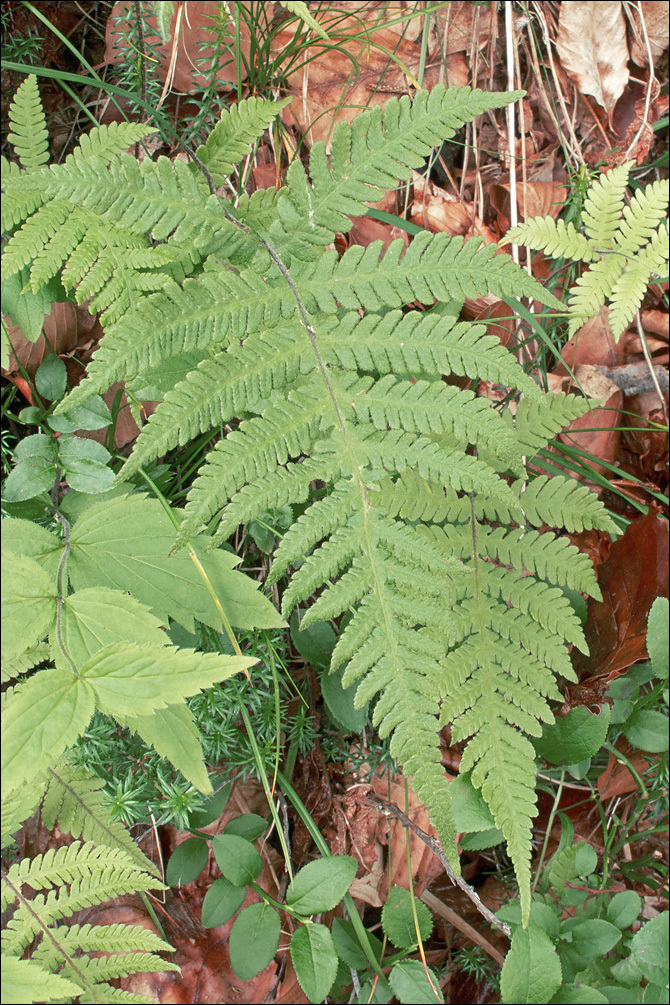
Slo.: navadna bukovica - syn.: Dryopteris phegopteris (L.) Christ.,Thelypteris phegopteris (L.) Sloss., Lastrea phegopteris (L.) Bory. - Habitat: overgrown old river deposits, edge of Fagus sylvatica forest, calcareous ground, locally acid ground (Vaccinium myrtillus dominant in ground vegetation), locally almost flat terrain, half shade, partly protected from direct rain by tree canopies, average precipitations ~ 3.000 mm/year, average temperature 4-5 deg C, elevation 995 m (3.300 feet), alpine phytogeographical region. - Substratum: soil. - Comment: Ferns are often neglected plants even by nature lovers. Allegedly they look 'all the same'. Truly they are not colorful and have no conspicuous sexual organs and in Europe some kind of green is almost all what they can display in terms of color. However, in a sense of graphical impact they can be strikingly beautiful. The richness of delicately shaped leaves is surprising. Species differ in habitus and morphological details, which are sometimes inconspicuous to such an extent, that proper determination of species is quite a demanding task and a trained eye is highly welcome. - Phegopteris connectilis is relatively easy to determine. It is a common, widespread, Euro-Siberian, North American fern, growing in all parts of the Alps, but in spite of this, it is seldom recognized by its name. Rather small but graceful plant can be recognized by its compound triangular or arrowhead-shaped leaves - fronds, which are pinnately divided. Their leaflets are further pinnately cleft almost to the midrib and, what is particularly characteristic for this species, broadly attached to the central axis of the leaf (see Fig.6.). Another easy to recognized trait is orientation of both largest leaflets at the bottom of the leaf. Both point backwards while all other leaflets point either forward or stand perpendicular to the central leaf axis (see Fig.2.). Spore producing organs in sori - black 'dots' on usually underside of fertile fronds - are positioned near the edge of the leaflets and have no umbrella-like protection cover called indusium like many other ferns. - Ref.: (1) M.A. Fischer, W. Adler, K. Oswald, Exkursionsflora sterreich Liechtenstein, Sdtirol, LO Landesmuseen, Linz, Austria (2005), p 237. (2) K. Lauber and G. Wagner, Flora Helvetica, 5. Auflage, Haupt (2012), p 60. (3) A. Martini et all., Mala Flora Slovenije, Tehnina Zaloba Slovenije (2007) (in Slovene), p 94. (4) D. Aeschimann, K. Lauber, D.M. Moser, J.P. Theurillat, Flora Alpina, Vol. 1., Haupt (2004), p 70.
-
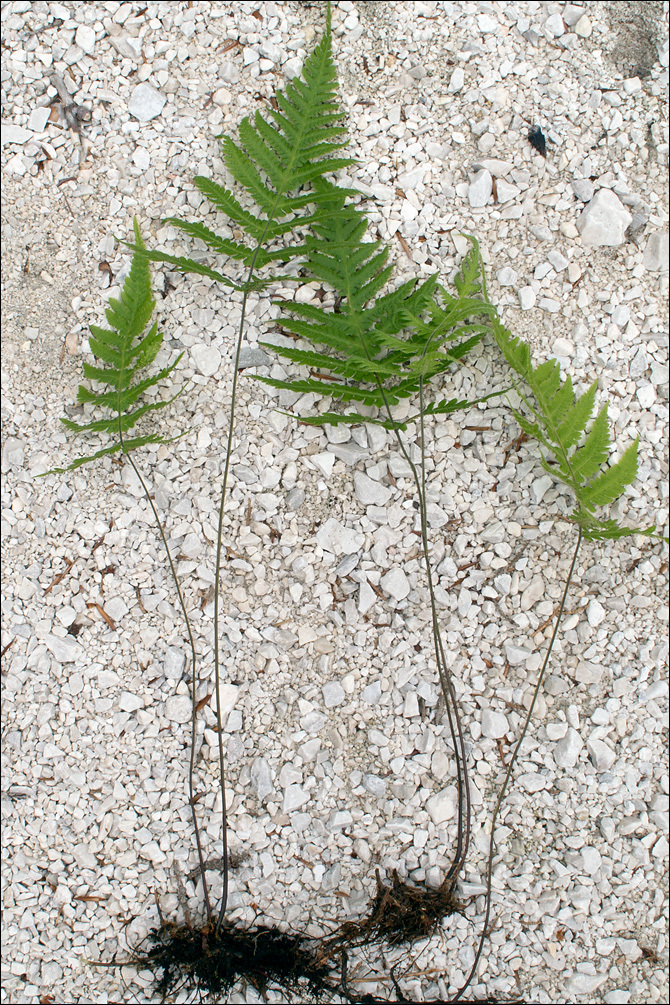
Slo.: navadna bukovica - syn.: Dryopteris phegopteris (L.) Christ.,Thelypteris phegopteris (L.) Sloss., Lastrea phegopteris (L.) Bory. - Habitat: overgrown old river deposits, edge of Fagus sylvatica forest, calcareous ground, locally acid ground (Vaccinium myrtillus dominant in ground vegetation), locally almost flat terrain, half shade, partly protected from direct rain by tree canopies, average precipitations ~ 3.000 mm/year, average temperature 4-5 deg C, elevation 995 m (3.300 feet), alpine phytogeographical region. - Substratum: soil. - Comment: Ferns are often neglected plants even by nature lovers. Allegedly they look 'all the same'. Truly they are not colorful and have no conspicuous sexual organs and in Europe some kind of green is almost all what they can display in terms of color. However, in a sense of graphical impact they can be strikingly beautiful. The richness of delicately shaped leaves is surprising. Species differ in habitus and morphological details, which are sometimes inconspicuous to such an extent, that proper determination of species is quite a demanding task and a trained eye is highly welcome. - Phegopteris connectilis is relatively easy to determine. It is a common, widespread, Euro-Siberian, North American fern, growing in all parts of the Alps, but in spite of this, it is seldom recognized by its name. Rather small but graceful plant can be recognized by its compound triangular or arrowhead-shaped leaves - fronds, which are pinnately divided. Their leaflets are further pinnately cleft almost to the midrib and, what is particularly characteristic for this species, broadly attached to the central axis of the leaf (see Fig.6.). Another easy to recognized trait is orientation of both largest leaflets at the bottom of the leaf. Both point backwards while all other leaflets point either forward or stand perpendicular to the central leaf axis (see Fig.2.). Spore producing organs in sori - black 'dots' on usually underside of fertile fronds - are positioned near the edge of the leaflets and have no umbrella-like protection cover called indusium like many other ferns. - Ref.: (1) M.A. Fischer, W. Adler, K. Oswald, Exkursionsflora sterreich Liechtenstein, Sdtirol, LO Landesmuseen, Linz, Austria (2005), p 237. (2) K. Lauber and G. Wagner, Flora Helvetica, 5. Auflage, Haupt (2012), p 60. (3) A. Martini et all., Mala Flora Slovenije, Tehnina Zaloba Slovenije (2007) (in Slovene), p 94. (4) D. Aeschimann, K. Lauber, D.M. Moser, J.P. Theurillat, Flora Alpina, Vol. 1., Haupt (2004), p 70.
-
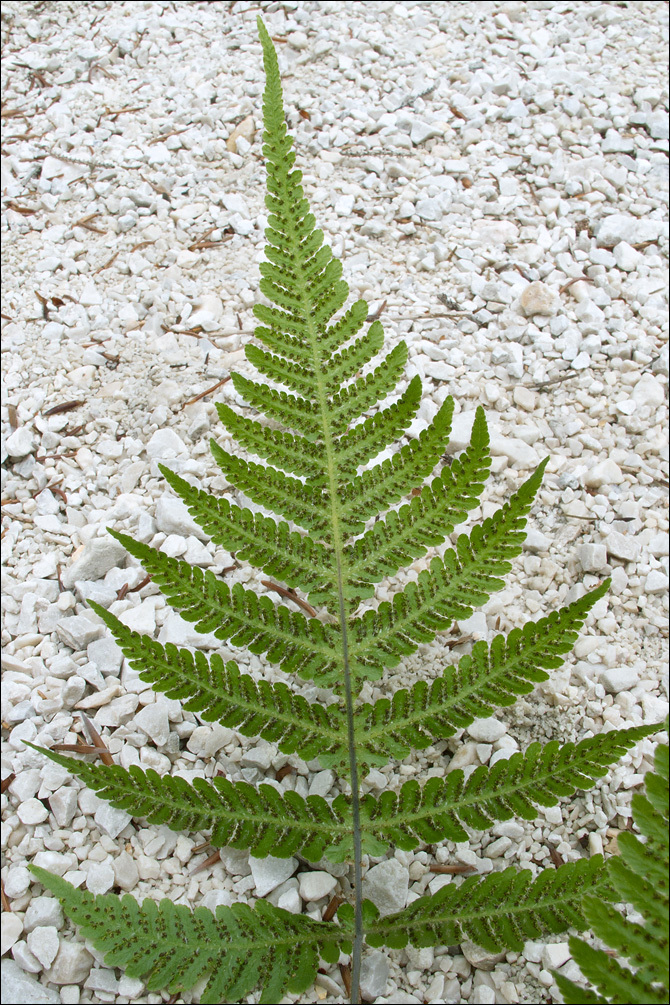
Slo.: navadna bukovica - syn.: Dryopteris phegopteris (L.) Christ.,Thelypteris phegopteris (L.) Sloss., Lastrea phegopteris (L.) Bory. - Habitat: overgrown old river deposits, edge of Fagus sylvatica forest, calcareous ground, locally acid ground (Vaccinium myrtillus dominant in ground vegetation), locally almost flat terrain, half shade, partly protected from direct rain by tree canopies, average precipitations ~ 3.000 mm/year, average temperature 4-5 deg C, elevation 995 m (3.300 feet), alpine phytogeographical region. - Substratum: soil. - Comment: Ferns are often neglected plants even by nature lovers. Allegedly they look 'all the same'. Truly they are not colorful and have no conspicuous sexual organs and in Europe some kind of green is almost all what they can display in terms of color. However, in a sense of graphical impact they can be strikingly beautiful. The richness of delicately shaped leaves is surprising. Species differ in habitus and morphological details, which are sometimes inconspicuous to such an extent, that proper determination of species is quite a demanding task and a trained eye is highly welcome. - Phegopteris connectilis is relatively easy to determine. It is a common, widespread, Euro-Siberian, North American fern, growing in all parts of the Alps, but in spite of this, it is seldom recognized by its name. Rather small but graceful plant can be recognized by its compound triangular or arrowhead-shaped leaves - fronds, which are pinnately divided. Their leaflets are further pinnately cleft almost to the midrib and, what is particularly characteristic for this species, broadly attached to the central axis of the leaf (see Fig.6.). Another easy to recognized trait is orientation of both largest leaflets at the bottom of the leaf. Both point backwards while all other leaflets point either forward or stand perpendicular to the central leaf axis (see Fig.2.). Spore producing organs in sori - black 'dots' on usually underside of fertile fronds - are positioned near the edge of the leaflets and have no umbrella-like protection cover called indusium like many other ferns. - Ref.: (1) M.A. Fischer, W. Adler, K. Oswald, Exkursionsflora sterreich Liechtenstein, Sdtirol, LO Landesmuseen, Linz, Austria (2005), p 237. (2) K. Lauber and G. Wagner, Flora Helvetica, 5. Auflage, Haupt (2012), p 60. (3) A. Martini et all., Mala Flora Slovenije, Tehnina Zaloba Slovenije (2007) (in Slovene), p 94. (4) D. Aeschimann, K. Lauber, D.M. Moser, J.P. Theurillat, Flora Alpina, Vol. 1., Haupt (2004), p 70.
-
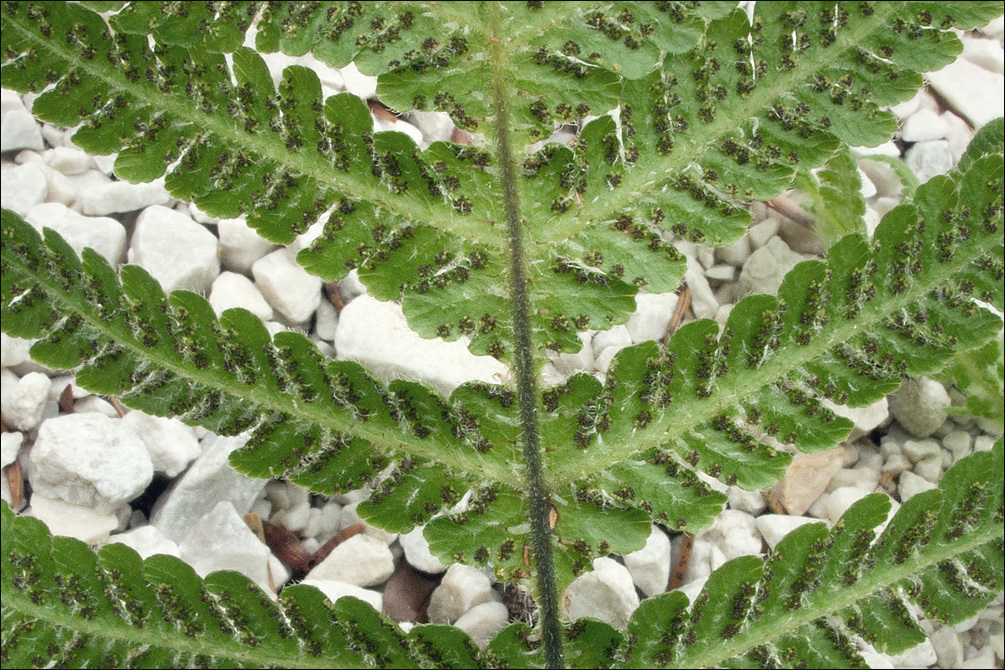
Slo.: navadna bukovica - syn.: Dryopteris phegopteris (L.) Christ.,Thelypteris phegopteris (L.) Sloss., Lastrea phegopteris (L.) Bory. - Habitat: overgrown old river deposits, edge of Fagus sylvatica forest, calcareous ground, locally acid ground (Vaccinium myrtillus dominant in ground vegetation), locally almost flat terrain, half shade, partly protected from direct rain by tree canopies, average precipitations ~ 3.000 mm/year, average temperature 4-5 deg C, elevation 995 m (3.300 feet), alpine phytogeographical region. - Substratum: soil. - Comment: Ferns are often neglected plants even by nature lovers. Allegedly they look 'all the same'. Truly they are not colorful and have no conspicuous sexual organs and in Europe some kind of green is almost all what they can display in terms of color. However, in a sense of graphical impact they can be strikingly beautiful. The richness of delicately shaped leaves is surprising. Species differ in habitus and morphological details, which are sometimes inconspicuous to such an extent, that proper determination of species is quite a demanding task and a trained eye is highly welcome. - Phegopteris connectilis is relatively easy to determine. It is a common, widespread, Euro-Siberian, North American fern, growing in all parts of the Alps, but in spite of this, it is seldom recognized by its name. Rather small but graceful plant can be recognized by its compound triangular or arrowhead-shaped leaves - fronds, which are pinnately divided. Their leaflets are further pinnately cleft almost to the midrib and, what is particularly characteristic for this species, broadly attached to the central axis of the leaf (see Fig.6.). Another easy to recognized trait is orientation of both largest leaflets at the bottom of the leaf. Both point backwards while all other leaflets point either forward or stand perpendicular to the central leaf axis (see Fig.2.). Spore producing organs in sori - black 'dots' on usually underside of fertile fronds - are positioned near the edge of the leaflets and have no umbrella-like protection cover called indusium like many other ferns. - Ref.: (1) M.A. Fischer, W. Adler, K. Oswald, Exkursionsflora sterreich Liechtenstein, Sdtirol, LO Landesmuseen, Linz, Austria (2005), p 237. (2) K. Lauber and G. Wagner, Flora Helvetica, 5. Auflage, Haupt (2012), p 60. (3) A. Martini et all., Mala Flora Slovenije, Tehnina Zaloba Slovenije (2007) (in Slovene), p 94. (4) D. Aeschimann, K. Lauber, D.M. Moser, J.P. Theurillat, Flora Alpina, Vol. 1., Haupt (2004), p 70.
-
-
-
-
-
-
-
-
-
-
-
2016 California Academy of Sciences
CalPhotos
-
2016 California Academy of Sciences
CalPhotos
-
2016 California Academy of Sciences
CalPhotos

